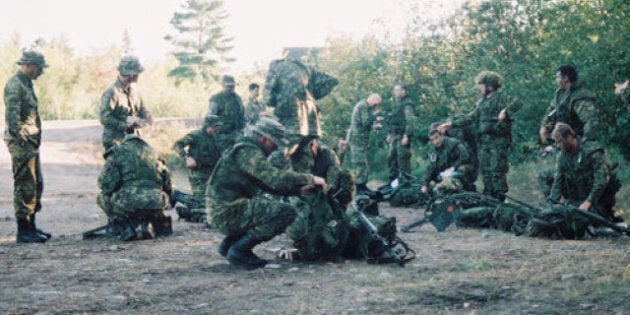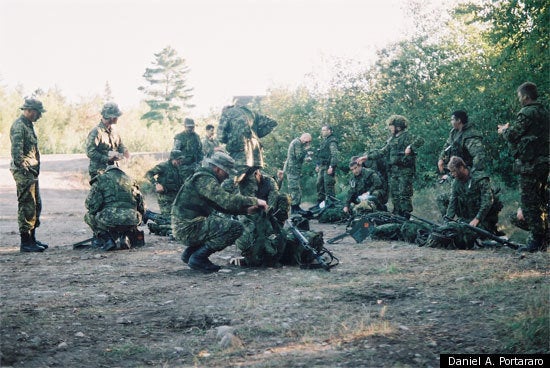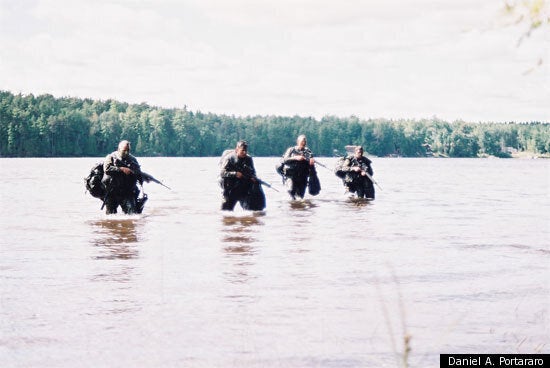
HuffPost contributor Daniel Portoraro spent a week with the Canadian Forces undergoing basic training. His unique perspective gave him a more personal insight into our soldiers' daily lives, and indeed into the broader debate over the future role of the military post-Afghanistan. This is part two of a four-part series, which will run every day until Thursday.
The soldiers' faces light up. "We're getting a LAV," their commanding officer says. There is no shortage of LAVs, Light Armoured Vehicles, in the Canadian Forces. Eight-wheeled, armoured, and equipped with a 25mm chain gun, this is a vehicle that that can take down helicopters; the bullets are roughly the size of beer bottles. The LAV is a mainstay of most armies, providing safe troop transportation and combat support in a variety of terrains. But at CFB Petawawa, the soldiers are excited to ride in one to their field exercise: It's like the real thing, the idea of going into battle; what they're here for, and it's a striking novelty to ride in such a damned impressive vehicle in a time of peace.
We hop into the LAV, four of us in back, three operating the vehicle. One of the commanding officers is standing up, sticking out of a turret hole, surveilling the scene with a superman's stare. He invites me to join him. As we drive along a dirt road, Canadian woodlands surrounding us on both sides, there is a feeling sheer beauty, but also heart-pounding excitement; we're en-route to learn a "capability" that, until now, has been only used in the Special Forces, and we're one of the first CF groups to try it out first-hand.
The BIP, boat inflation point, is some 15 minutes away from the 3RCR building. We pass through a checkpoint, and the officer beside tells me that as of now, we could do whatever we wanted to the terrain. Whether it's firing exercises, grenade drills, or even artillery strikes it doesn't matter, because the land is completely ours, he says; it's the Canadian Forces' sandbox.
I sit back down with the other two soldiers in the LAV, a master corporal and a corporal who next week will be posted in Poland for translation duties. On the surprisingly smooth ride, they're applying their camouflage makeup, using the mirrors from their compasses. They squeeze out a green paste from a tube and gently apply it to their faces. The idea of doing so roughly, intensely with the air of a Mohican tribesman is something only for the movies. Their faces are completely covered, right down to their nostrils and eyelids. They look alien. They then apply some brown coloring, streaking it across their faces to "flatten" their features. I do the same, and at first it feels weird, but in a few minutes I won't notice it anymore, the same way I won't notice, a couple of hours later, soldiers hiding in the bushes: Pair the paint with a uniform, and you're completely invisible to the naked eye.
We pull up to the beach. It's a lust-worthy sight for anyone in the market who wants to buy a riverfront cottage. Trucks litter the sandy banks, with groups of green-clad soldiers either getting their kit ready, or listening to a dip-spitting sergeant explaining how "fast-casting" works. Boxes of ammunition are plentiful, and every single round is a live one. A corporal picks up one these boxes and pulls out a chain of bullets. They're for a C6 GPMG, a machine gun that can fire 650-1,000 rounds a minute. He points to every fifth bullet, which is red-tipped with phosphorous. This is called a tracer, he tells me. It emits a bright trail that when fired shows soldiers where the bullet is headed. If the gunner has spotted the enemy and fires a tracer at him, the other men in his platoon will focus all of their firepower onto that target; a sure way to guarantee victory. LAVs often have them mounted as turrets. Combat support groups, like the ones today on the beach, wield them in-hand. It weighs about 30 pounds.

Joining the troops on the sand, I attract a few curious glances; I'm not dressed in the usual CF uniform, but rather, the garb reserved for "enemy" troops in field exercises, and my notebook doesn't help. I stand out, but within a matter of minutes, am approached by various soldiers, keenly interested in what I'm doing, and more than willing to answer my questions.
The sergeant calls us in, and as we surround a black assault raft on the beach, he demonstrates how to rectify a capsizing. Head shaven, and spitting between every other word, he seems like a man straight out of famed war novels, but without the yelling or gruff nature.
After the "safety" procedure, he explains "fast-casting." It's a form of field insertion that the Canadian Forces have recently decided to teach all members of Light Battalions. Essentially, the maneuver has a group of soldiers, typically four, plus a driver, plow through a body of water on an assault raft towards their target. They move quietly and stealthily, prepped to storm an area without being detected.
The sergeant places two of us on each tube of the raft. Wearing flippers, we have one foot on the craft's floor, the other in the water, positioned as if riding a horse. We're told to crouch down as much as we can, one hand keeping our backpacks stuck firmly between our armpit, the other holding a C7 assault rifle, aimed away from the watercraft.
The driver laughs when I ask him if there are normally turrets on board. "You're the turret," he says.
With one soldier behind me, and two more on the other tube, we push off the beach and ride along the Ottawa River to our destination: Green Beach, where we're to regroup with a reconnaissance unit who's going tell us our next objective.
This is the easy part of fast-casting. After positioning us, the sergeant tells us what we're actually supposed to do. We somersault out of the raft, as it continues to drive forward. Fifty or so yards from the beach, the driver yells "Go!" and in pairs, starting with the rear, the soldiers push off with their flippered foot on the floor of the boat, and, keeping their head locked to the waterside, somersault into the water.
At first, the exercise seems frightening. After all, this assault raft has quite the propeller blade, and one that could easily cut through a man's arm. However, on the beach, the sergeant spends a great deal of time explaining how to properly perform the maneuver, thus avoiding being chewed up by the blades.
"You're going to push off, turn into the water, and using your momentum, hurl yourself out of the way of the boat," he says, "and then you're going to make your way to the beach." He looked at me, and jokingly added "or to the barber."
This is a regular facet of the Canadian Forces. Briefings for the exercises are straightforward, detailed, and comprehensive. And unlike in what one would normally expect, questions aren't met with a yelling sergeant, but rather are encouraged as they demonstrate attentiveness. And while humour does seem to be rampant in the forces, it's almost activated by a switch. One moment, soldiers might be tackling each other out of boredom, but when called over by a sergeant to listen to a debriefing, their faces suddenly become serious and still.
As we ride along the river, I look around me. The scenery is untouched, and it's striking to see crystalline water, and blood-red leaves backdropping a young blonde in full camo, wielding an assault rifle that could easily turn a man into Swiss cheese. Everyone is quiet, the only noise the soft splashing of waves, and a foreboding motor. It's a new exercise, and requires the utmost concentration.

My heart begins to pound as I see the green sign of the beach. I see other black rafts ahead, and can't be sure if the troops are fast-casting off them yet until I see their bodies make small, white explosions into the water.
Any moment now, I say to myself. And the second I do, the driver yells "Go!" and the two men behind me somersault into the water with a crash. My cue and I push off as well; a split second effect with no time for thought.
Noise, darkness, freezing cold, and suddenly, relief and realization that my arm hasn't been torn off. I swim up to the cool surface, and stick out my thumb; the universal sign that everything's okay. Using our packs as floatation devices, we slowly flipper our way a hundred meters to the shore. And the moment we touch ground, take them off. We're not wearing wet-suits, but full-on infantry garb. Soaking, dripping wet, and in my case, cold (soldiers, possessing an almost superhuman capacity for adrenalin, don't seem to notice their water-filled boots), we make our way to the woodlands to regroup with the reconnaissance unit that's about to tell us the next part of our mission...